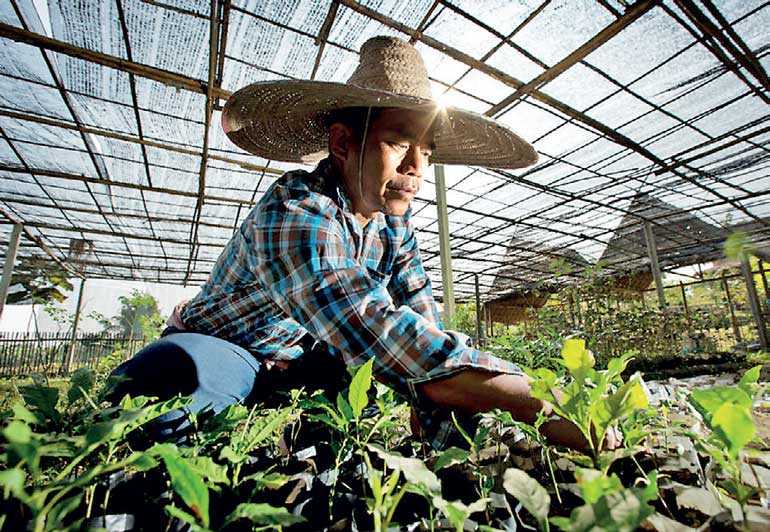Tuesday Mar 04, 2025
Tuesday Mar 04, 2025
Thursday, 1 November 2018 00:00 - - {{hitsCtrl.values.hits}}

Over the years, the concept of carbon offsetting has had a tumultuous reception. Before the worldwide financial crisis, the heyday of the carbon credit marketplace saw many companies investing in credits – often without a very clear picture of what was involved. To this date, emerging and developing marketplaces (such as Sri Lanka) suffer from a significant dearth of information or an abundance of misinformation (whichever way you want to look at it) about this fundamental environmental mechanism. 
A ‘Carbon Credit’ is a unit of measure of the credit given to someone or an entity should they reduce their greenhouse gas (GHG) emissions by 1 unit (equal to 1 tonne of Carbon Dioxide Equivalents [tCO2e]). These reductions usually come from renewable energy or forestry projects, which,whilehaving positive environmental and social impacts, have less than desirable financial rates of return. Therefore, in order to meet the standards of commercial viability, these projects offer an exchange of their carbon reductions (i.e. carbon credits) for a financial investment in the project itself. The additional financial inflow will result in the project meeting the required financial viability. The uptake of these credits is from ‘carbonoffsetters’ – typically companies who want to compensate for their own carbon emissions to achieve a ‘net-zero emission’or carbon neutral status. According to the World Resource Institute, a carbon offset can be defined as a reduction in emissions of carbon dioxide or greenhouse gases made in order to compensate for or to offset an emission made elsewhere. Usually, the projects supported by carbon offsets were situated in diverse geographical locations nowhere near the scope of operations of the company trying to offset its footprint.In today’s increasingly environmentally-conscious corporate world, this isseen as less than desirable. Add to that the financial cost of preparing, validating and registering a carbon credit project under one of the international carbon standards and voila – you have just paved the way for the creation of an innovative carbon reduction mechanism,Carbon Insetting.
According to The International Carbon Reduction and Offset Alliance (ICROA), the term insetting was first used in 2009 to refer to the direct investment of a company within its own value chain (up and downstream) in order to reduce its carbon footprint. ICROA defines the term as “a carbon reduction project, verified by an offset standard, which occurs within a company’s supply chain or supply chain communities”.
ICROA’s research has shown that emission reduction projects deliver a range of socio-economic and environmental benefits to local communities, in addition to mitigating climate change. Companies that choose to invest in insetting and locate emission reduction projects within their own supply chain are able to capture more of these non-carbon benefits. In turn, this can lead to additional return on investmentthrough increased supply chain efficiency and customer loyalty.[Source: https://www.icroa.org/Insetting]
The flexibility provided by the insetting option allows companies to make financial investments in carbon offset projects that generate environmental, social and/or economic value for the company, itssuppliers and buyerslocated within its supply/value chain,supply/value chain communities (defined as the stakeholders that have a direct link with the supply/value chain, or impacted by supply/value chain activities) or its sphere of influence from an operational standpoint. The projects can be developed by:
The carbon sequestered in such a project will be evaluated against the requirements and principles of internationally recognised insetting standards. These principles include additionality, uniqueness, measurability, permanence and verifiability. However, the costly (and time consuming) step of submitting the project for international validation and registration is not a requirement. What is required is a minimum of an independent 3rd party verification that the project conforms to a clearly defined and internationally accepted carbon standard and that the quantified GHG emission reduction can only be accounted for once, either by the company or by the project developer. This is to avoid double counting of the reduction.
Given this new approach, companies are now likely to see newer benefits to carbon sequestration, such as:
Showcasing a forward-looking approach to corporate sustainability.Insetting enables you to generate positive environmental and social impacts with a direct link to your business. The tangible impacts generated by the project provide an exceptional opportunity to enhance your brand by communicating your achievements through inspiring storytelling.
The customised approach of insetting allows you to design projects that are directly linked to your supply/value chain sustainability targets. These targets could include improving community health and education, empowering women, reducing deforestation and flood resilience or biodiversity conservation. With a careful alignment of incentives, these projects can turn business risks into opportunities, thereby creating shared value.
Risks linked to ecosystems and communities increasingly affect companies’ core businesses. Livelihoods of local farmers threatened by climate change, degrading soils and inefficient supplier operations are risks that could potentially endanger or even disrupt companies’ supply chains. Decreasing water resources may lead to business interruptions. A lack of community engagement and mounting local opposition to a company’s operations on the ground can threaten its social license and legitimacy to operate. At the same time, the rapid economic growth in developing countries opens up a wide array of new business opportunities waiting to be unlocked.[Source: The South Pole Group]
The writer is the CEO of Carbon Consulting Company.
Discover Kapruka, the leading online shopping platform in Sri Lanka, where you can conveniently send Gifts and Flowers to your loved ones for any event including Valentine ’s Day. Explore a wide range of popular Shopping Categories on Kapruka, including Toys, Groceries, Electronics, Birthday Cakes, Fruits, Chocolates, Flower Bouquets, Clothing, Watches, Lingerie, Gift Sets and Jewellery. Also if you’re interested in selling with Kapruka, Partner Central by Kapruka is the best solution to start with. Moreover, through Kapruka Global Shop, you can also enjoy the convenience of purchasing products from renowned platforms like Amazon and eBay and have them delivered to Sri Lanka.
Discover Kapruka, the leading online shopping platform in Sri Lanka, where you can conveniently send Gifts and Flowers to your loved ones for any event including Valentine ’s Day. Explore a wide range of popular Shopping Categories on Kapruka, including Toys, Groceries, Electronics, Birthday Cakes, Fruits, Chocolates, Flower Bouquets, Clothing, Watches, Lingerie, Gift Sets and Jewellery. Also if you’re interested in selling with Kapruka, Partner Central by Kapruka is the best solution to start with. Moreover, through Kapruka Global Shop, you can also enjoy the convenience of purchasing products from renowned platforms like Amazon and eBay and have them delivered to Sri Lanka.